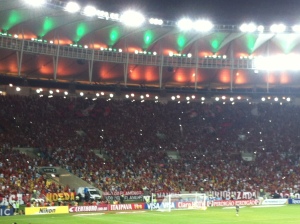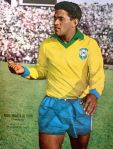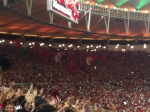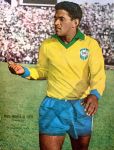
A crowd of 60,000 watch Flamengo win 4-0 against Botafogo in the Brazilian Cup quarter-final at the Maracanã
By Sam Green
Sunday, July 25, 2010 turned out to be a seminal day. For me at least. It was the day I met Maísa in a café in Rio de Janeiro. She would go on to be my wife. It was also the day I went to my first Botafogo match. They would become my Brazilian team. “So fate gave you a very bad thing to balance up the very good thing,” says Lucas, my Flamengo-supporting friend.
“Why did you pick Botafogo? Do you like suffering?” ask my wife’s cousins, all flamenguistas. I explain: I read a bit about their history and liked it – their players formed the basis of Brazil’s first two World Cup wins, in 1958 and 1962. They had Garrincha. And Nilton Santos. Plus, I must admit, I was a little enchanted by the club’s reputation as the team of Rio’s intellectuals, artists and bohemians. Pretentious, I know.
And I also disliked what I read of the backstory of Fluminense, their opponents that day. Founded by an upper-class Englishman and seemingly tainted by the snobbery that often comes hand in hand with all that. It was a natural rejection.
So a decision was made. It would be the lone star of Botafogo. O Glorioso. For better or worse.
Although not everyone agrees. There’s still time to change, the flamenguistas tell me. You made a mistake, it’s OK, you can still join us. Even: you’re not really a Botafogo fan, you’re a Flamengo fan, you just haven’t realised it yet. You haven’t admitted it to yourself. You’ll come around.
And it can be hard to resist Fla. The thing about flamenguistas is there are so bloody many of them. The call themselves A Nação (The Nation). Yes, they can be irritating: the team seems to get a lot of refereeing decisions and their fans’ sense of ownership can grate. “The Maracanã is ours” is a favourite refrain about the shared stadium that connects so profoundly with the soul of Brazilian football.
But Flamengo are very much the people’s team and that, for me, makes them hard to dislike. It’s a bit like West Ham with Man United’s following. Or Liverpool, I guess Reds fans would say. Flamengo are proud of being O Povo (the people). And the only time I’ve been ashamed of my nascent allegiance to Botafogo is when I heard their fans calling Fla supporters favelados (a derogatory term for people who live in favelas).
There are a few theories about the roots of Flamengo’s universal appeal. It’s been said they were the first Rio club to give a chance to black players, but this is incorrect: it was in fact Bangu (now a minor Carioca club) and Vasco de Gama were the first of the existing big Rio sides to do so. This leads to a rival claim that provokes strong reactions: that Vasco are the true people’s club. That the story of Mengo is a myth. And Vasco do hail from the poorer north zone of Rio, and their stadium is in a decidedly dodgy area, while Flamengo are based in upper-class Gávea.
Another, more credible theory to explain Flamengo’s vast popularity is that they were the first club to hold open training sessions, demystifying football, which started life in Brazil as an upper-class pursuit, closed off to the poor. Which brings us back to Fluminense. Flamengo were born out of a splinter group who split from Fluminense, and this rivalry (the povo vs the elite) has come to define both clubs.
Botafogo, meanwhile, are a team for wistful old men, stuck in the past, apparently. The other teams, Flamengo in particular, sing a song to Botafogo called Chororô, which can be roughly translated as Cry, Cry. The words go something like: “The chairman’s crying, the players are crying, the fans are crying – the whole club’s crying” – in reference to a perceived victim-syndrome, an enduring sense among botafoguenses that they are cursed by bad luck and injustice.
That seemed to be turning around this year. The arrival of Clarence Seedorf, who married into a family of botafoguenses and is still in frighteningly good shape at 37, plus the breakthrough of a batch of confident youngsters under the guidance of studious manager Oswaldo de Oliveira, saw Fogo confidently claim the Rio state title and then enter into national title contention, as the other big Carioca clubs – Fla, Flu and Vasco – hovered around the relegation zone.
But a defeat by title rivals Cruzeiro in September seemingly punctured confidence and a string of poor results has put qualification to the Copa Libertadores (a feat not achieved since 1996) in doubt. So last week’s second leg of the Brazilian Cup quarter-final against Flamengo took on an increased profile – the tournament winners qualify for the continental tournament.
“Arriving at the Maracanã and seeing the overwhelming masses of rubro-negros swarming outside, it was difficult to imagine any team overcoming such a force of nature.”
It was 1-1 from the first leg and excitement had been building all week. Arriving at the Maracanã and seeing the overwhelming masses of rubro-negros (red and blacks = Fla fans) swarming outside, it was difficult to imagine any team overcoming such a force of nature. Each set of fans had their own end behind a goal and Fla seemed to have claimed the two ‘neutral’ sides too. In a crowd of 60,000, it felt a fair guess to say that 45,000 were Mengo.
We were in the ‘prawn sandwich’ seats, but there was still a pleasing amount of passion and coarse behavior. Seat numbers on tickets were cheerfully ignored and nobody seemed overly interested in sitting anyway. Among a raft of new regulations ushered in with the opening of the new Maracanã was a ban on fans taking their shirts off: something else that was largely ignored. And this makes sense in early summer in Rio, unlike Newcastle in December.
It was a chastening night for Botafogo. With Seedorf having a stinker, and rangy forward Rafael Marques unable to impose himself, Flamengo’s blood and thunder no. 9 Hernane stole the show, completing his hat-trick in the 12th minute of the second half. Nicknamed ‘The Drill’, the rumbustious Hernane was plucked from the São Paulo state league during a frugal close-season at Flamengo, and currently has the esteemed Carioca honour of being top scorer at the new Maracanã. Loyal club servant and birthday boy Leo Moura, a graceful and effective right-back, made it 4-0 from the penalty spot, earning a rendition of happy birthday from the fans. And that was that.
But the real show had been in the stands. Despite raised ticket prices at the new stadium and fears of gentrification, the atmosphere was electric – all four sides spent large portions of their time jumping, singing, swearing and waving unfeasibly large flags. The nature of the defeat hit the botofoguenses hard. One lad sitting near us in his black and white striped shirt, alongside his rubro-negro-clad girlfriend, got so upset at the third goal that he jumped up and started kicking the wall in front of him, before storming off.
The one disappointment was how quickly the Botafogo end emptied out after the third goal – it was the opposite of the bloody minded British mentality you often see with beaten fans staying on to show their passion for the club, even more defiantly in the face of humiliation. Saying that, the 10pm kick-off on a school night (because of the power of TV schedulers who want to protect the prime-time soap opera audiences) made the early exodus slightly more understandable.
It was after the fourth goal that a colleague of mine shouted of “Oi, chupa Sam!”. At first I thought he was calling me ‘Super Sam’ and I happily waved back. Then I realised he was actually telling me to ‘suck it’. With this in mind, I slipped away five minutes from the end, keen to avoid sharing the metro with 45,000 delirious and gloating flamenguistas. On the platform I joined my kind: sad, tired, disappointed faces.
But I have to be honest. I just don’t care all that much anymore. It would be worse if it was Brighton. Or England. But even then, it just doesn’t cut deeply these days, like it used to. Football still distracts, thrills and fascinates me. But I don’t get so down about it anymore. I won’t be kicking any walls. Sometimes, I worry that I’ve lost something. But I guess I’ve just grown up. I’m getting on a bit. Which is perfect for Botafogo.
Sam Green is an English football writer and lifelong Brighton & Hove Albion fan, now living and working in Rio.
- The Maracanã, before its renovation, when it had a capacity of around 96,000
- The Maracanã, renovated this year in time for next year’s Fifa World Cup finals in Brazil
- A crowd of 60,000 watch Flamengo win 4-0 against Botafogo in the Brazilian Cup quarter-final at the Maracanã
- Flamengo ease to victory over Botafogo in the Brazilian Cup quarter-final at the Maracanã
- Flamengo fans dominate the crowd in the Maracanã
- Former Botafogo legend Garrincha
- The badge of Botafogo de Futebol e Regatas
- Botafogo’s home stadium, Estádio Olímpico João Havelange, or Engenhão
- Botafogo fans fly a huge flag bearing the image of Garrincha











Nice text, Sam! Good reading.
Well, it’s not that you don’t care anymore, it’s simply that you are supporting Botafogo – you have not to care to protect your emotions…
Rica Perrone – a Brazillian football critic well known for being able to understand de spirit of all Brazillian clubs when he writes – wrote about that mach. Take a look:
http://www.ricaperrone.com.br/uma-seita-chamada-flamengo/
Saudações rubro-negras!
Hello Web Admin, I noticed that your On-Page SEO is is missing a few factors, for one you do not use all three H tags in your post, also I notice that you are not using bold or italics properly in your SEO optimization. On-Page SEO means more now than ever since the new Google update: Panda. No longer are backlinks and simply pinging or sending out a RSS feed the key to getting Google PageRank or Alexa Rankings, You now NEED On-Page SEO. So what is good On-Page SEO?First your keyword must appear in the title.Then it must appear in the URL.You have to optimize your keyword and make sure that it has a nice keyword density of 3-5% in your article with relevant LSI (Latent Semantic Indexing). Then you should spread all H1,H2,H3 tags in your article.Your Keyword should appear in your first paragraph and in the last sentence of the page. You should have relevant usage of Bold and italics of your keyword.There should be one internal link to a page on your blog and you should have one image with an alt tag that has your keyword….wait there’s even more Now what if i told you there was a simple WordPress plugin that does all the On-Page SEO, and automatically for you? That’s right AUTOMATICALLY, just watch this 4minute video for more information at. Seo Plugin
Dear xnrlqzlpdtb,
May I kindly suggest you fuck off and die?
Thanks
Swifty
Cheers Swift (does sex face)!